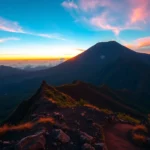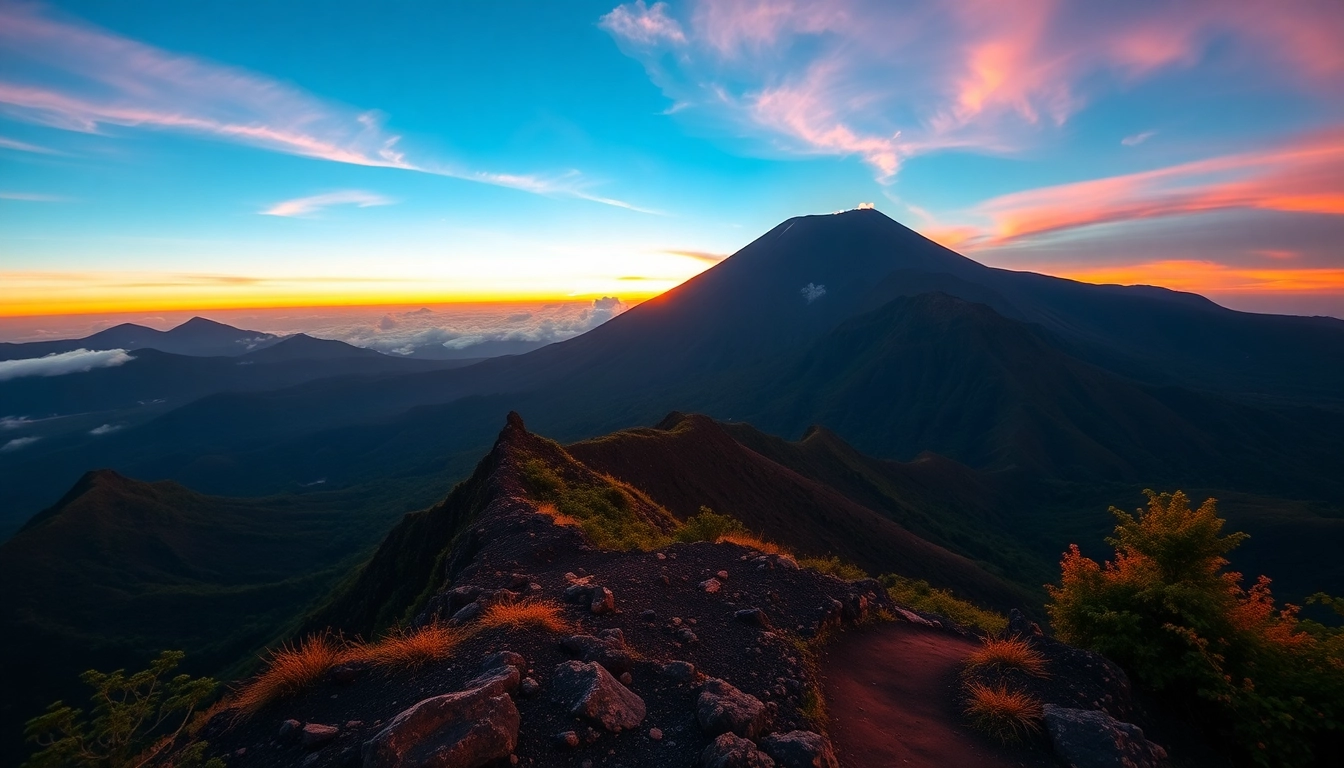Understanding Mount Rinjani: Geography and Volcanic Significance
Location and Geological Features of Mount Rinjani
Mount Rinjani stands as Indonesia’s second highest volcano, commanding the landscape of Lombok Island in West Nusa Tenggara. With an elevation of 3,726 meters, this active volcano is a prominent geological feature, notable for its complex caldera system, prolific volcanic activity, and diverse geological formations. Located within the expansive Gunung Rinjani National Park, it stretches across approximately 41,330 hectares, encompassing lush rainforests, hot springs, waterfalls, and fertile volcanic soils. The volcano’s structure comprises a massive caldera filled with the spectacular Segara Anak (Child Sea) crater lake, which is approximately 1,100 meters deep and renowned for its striking turquoise waters.
The geological composition of Rinjani is primarily basaltic and andesitic lava flows, indicative of its active status. Its central cone, known as Barujari, intermittently erupts, shaping the surrounding landscape through its dynamic volcanic activity. The region’s seismic activity reveals a complex system of magma chambers, making Rinjani a focal point for volcanologists and geologists studying volcanic processes in Southeast Asia.
For more detailed information about its geological attributes, visit this Wikipedia article.
Historical Eruptions and Volcanic Activity
Mount Rinjani’s eruption history is well-documented, with notable activity recorded over centuries. The most significant recent eruption occurred in 2015, lasting nearly two months and affecting air travel, local communities, and the environment. During this period, ash plumes reached heights of up to 6 kilometers, and lava flows reshaped parts of the crater landscape. These eruptions are characterized by strombolian and phreatomagmatic activity, often accompanied by seismic tremors and ash clouds.
Historical records trace eruptions back as far as the 19th century, with some prior eruptions unrecorded but evidenced by geological deposits. The volcanic activity remains monitored continuously by Indonesia’s Volcanological Survey, which uses seismic instruments, thermal cameras, and gas sensors to predict eruptions and ensure safety.
It is essential for trekkers and residents to heed eruption alerts from local authorities to avoid danger during periods of heightened activity.
The Role of Mount Rinjani in Indonesian Volcanism
Mount Rinjani is a critical part of the Sunda Arc, a major volcanic arc associated with subduction processes along the Indo-Australian Plate beneath the Eurasian Plate. Its activity contributes significantly to Indonesia’s reputation as the “Ring of Fire,” hosting over 76 active volcanoes. Rinjani’s eruptions have historically deposited fertile volcanic ash across Lombok, enhancing agricultural productivity and supporting local livelihoods.
Moreover, Rinjani serves as an invaluable natural laboratory for geoscientists studying volcanic processes, plate tectonics, and geothermal phenomena. Its geothermal potential is also harnessed for sustainable energy projects, aiming to reduce reliance on fossil fuels.
Understanding Rinjani’s role in regional volcanism emphasizes the importance of ongoing monitoring and disaster preparedness for communities and visitors alike.
Preparing for Your Trekking Adventure on Mount Rinjani
Mandatory Equipment and Permits
Preparing for a trek on Mount Rinjani requires meticulous planning. Essential equipment includes a sturdy hiking backpack, layered clothing suitable for variable mountain weather (including windproof jackets, thermal layers, and rain gear), sturdy trekking boots with ankle support, gloves, and a hat for sun protection. Additionally, trekkers should carry headlamps, trekking poles, first aid kits, high-energy snacks, water purification systems or tablets, and a portable stove if camping.
Permits are mandatory for trekking in Gunung Rinjani National Park, with costs varying based on the route and duration. It is recommended to book guided tours through authorized agencies, as they handle permit procurement, often included in their packages. Unauthorized climbs are illegal and pose safety and environmental risks.
Best Seasons and Timing for Climbing Mount Rinjani
The optimal trekking seasons are during the dry seasons, typically from May to October, when weather conditions are most favorable. During these months, the skies are clearer, and the risk of rain or storms is minimized, providing safer and more enjoyable climbs. The wet season, from November to April, often features heavy rainfall, muddy trails, and increased volcanic activity, making the trek more dangerous.
Climbers should also consider local festivals and cultural events, which often coincide with the dry season, offering a richer experience.
Choosing Guided Tours and Local Support
Guided trekking is strongly recommended due to the mountain’s challenging terrain and unpredictable weather. Experienced guides provide route navigation, safety assurance, and local insights, enhancing the overall experience. Many companies offer packages that include permits, accommodation, meals, porters, and emergency support.
Supporting local communities through authorized guides promotes sustainable tourism, ensures safety, and enriches cultural exchange.
Trail Routes and Key Highlights of Mount Rinjani Trekking
Sembalun vs. Senaru Routes: Pros and Cons
Two primary trekking routes lead to the summit of Mount Rinjani: Sembalun and Senaru, each offering unique experiences. The Sembalun route, starting from the east, is renowned for its relatively gentle terrain, panoramic views, and a more gradual ascent, making it suitable for trekkers with moderate fitness levels. It passes through beautiful savannah landscapes and offers scenic vistas of the surrounding islands.
Conversely, the Senaru route, from the north, is steeper and more challenging but provides lush rainforests, waterfalls, and close encounters with Rinjani’s diverse flora and fauna. It is favored by experienced trekkers seeking a more immersive natural experience.
Both routes culminate at the crater rim, from where climbers can descend to Segara Anak Lake.
Must-See Spots: Segara Anak Lake and Hot Springs
The highlight of Rinjani trekking is the breathtaking Segara Anak, a volcanic crater lake nestled within the caldera. Its shimmering waters are a stunning sight against the rugged volcanic landscape, and visitors often trek here for the impressive sunrise views.
Nearby hot springs, such as the Aik Berik Hot Springs, provide a relaxing experience after challenging hikes. These natural thermal baths are believed to have therapeutic properties and are a favorite among trekkers for soothing tired muscles.
Exploring these natural wonders offers insight into the geothermal activity beneath Rinjani’s surface.
Handling Challenges and Altitude Sickness
The ascent to Mount Rinjani presents physical challenges, including high altitude, rugged terrain, and rapidly changing weather. To mitigate altitude sickness, gradually acclimate during previous hikes, stay well-hydrated, and ascend slowly. Recognizing symptoms like headaches, dizziness, and nausea is crucial to prevent severe health issues.
Proper pacing, rest periods, and altitude training can improve your resilience. Guided groups are especially vigilant about monitoring symptoms and providing necessary interventions.
Safety, Permits, and Environmental Responsibility
Understanding Volcano Risks and Emergency Procedures
Despite the thrill of adventure, trekkers must be aware of potential volcanic hazards, such as eruptions, ash clouds, and seismic activity. Always heed warnings and updates from local authorities and park rangers. Emergency procedures include evacuation plans, communication protocols, and access to medical assistance.
Carrying a first aid kit and communicating with local emergency services are vital components of safety planning.
Conservation Practices for Mount Rinjani
Protecting Rinjani’s pristine environment requires adhering to Leave No Trace principles. Trekkers should dispose of waste responsibly, avoid disturbing wildlife, and refrain from collecting plants or rocks. Staying on designated paths prevents soil erosion and habitat destruction.
Supporting eco-friendly operators and participating in park conservation initiatives help preserve Rinjani’s natural beauty for future generations.
Local Regulations and Respectful Tourism
Visitors are expected to respect local customs and regulations. This includes dressing modestly, seeking permission before photographing locals, and supporting local businesses. Permits and entry fees contribute directly to park maintenance and community development.
Cultivating respectful attitudes ensures that tourism remains sustainable and beneficial for the Lombok communities.
Post-Trek: Experiences and Cultural Insights
Connecting with Lombok’s Local Culture
After conquering Rinjani, immersing yourself in Lombok’s rich cultural heritage enhances your travel experience. Engage with local artisans, participate in traditional crafts such as weaving and pottery, or attend cultural performances in villages like Sembalun or Senaru. Learning about Lombok’s indigenous Sasak culture and their spiritual connection to Rinjani deepens appreciation for the mountain’s significance.
Supporting community-based tourism initiatives promotes sustainable development and cultural preservation.
Additional Activities Near Mount Rinjani
Beyond trekking, Lombok offers various activities such as visiting Gili Islands for pristine beaches, exploring waterfalls like Tiu Kelep and Sendang Gile, or learning surfing along the southern coasts. Diving, snorkeling, and island-hopping provide aquatic adventures, while cultural tours reveal the island’s history and local traditions.
Tips for Sharing Your Adventure and Leaving No Trace
Sharing your Rinjani experience through social media and storytelling can inspire others. Remember to promote responsible tourism by minimizing environmental impact—dispose of waste properly, avoid damaging flora and fauna, and respect local communities. Use eco-friendly gear and encourage fellow travelers to follow sustainable practices.





